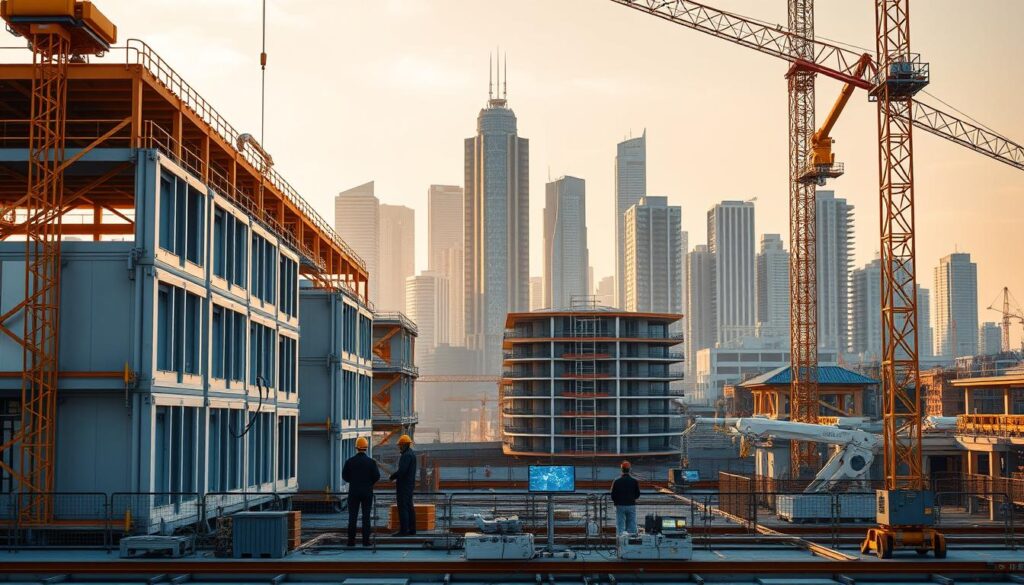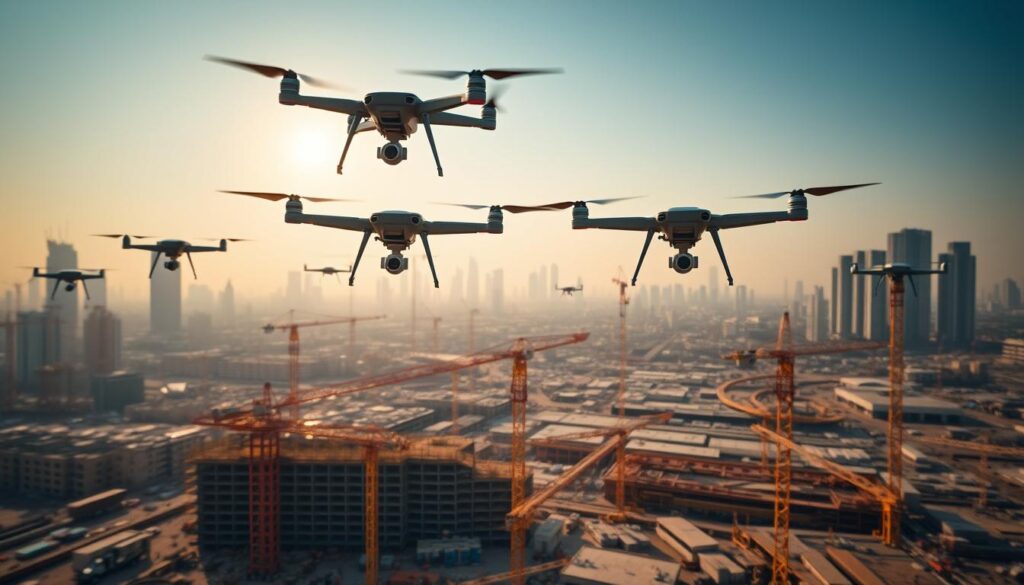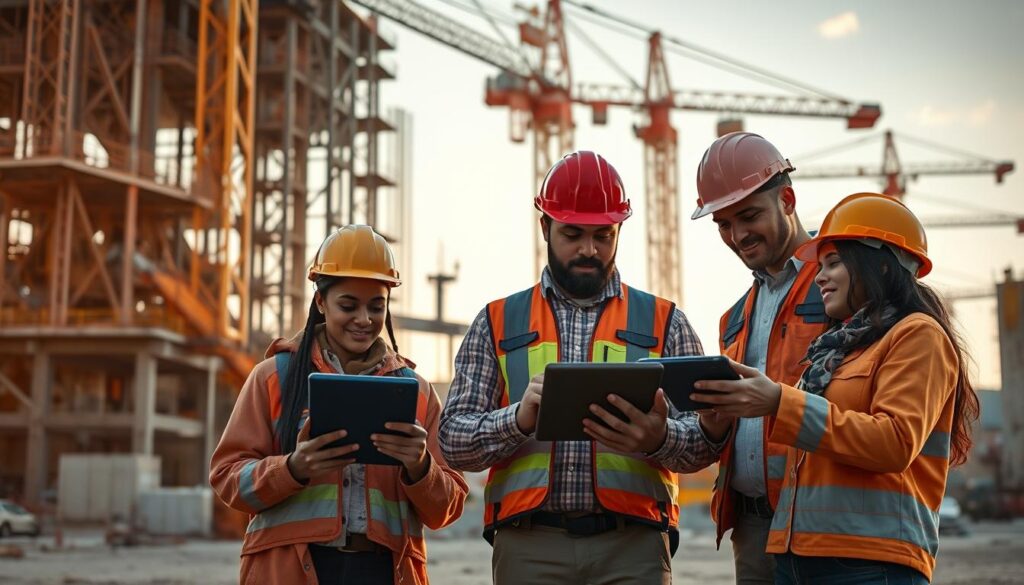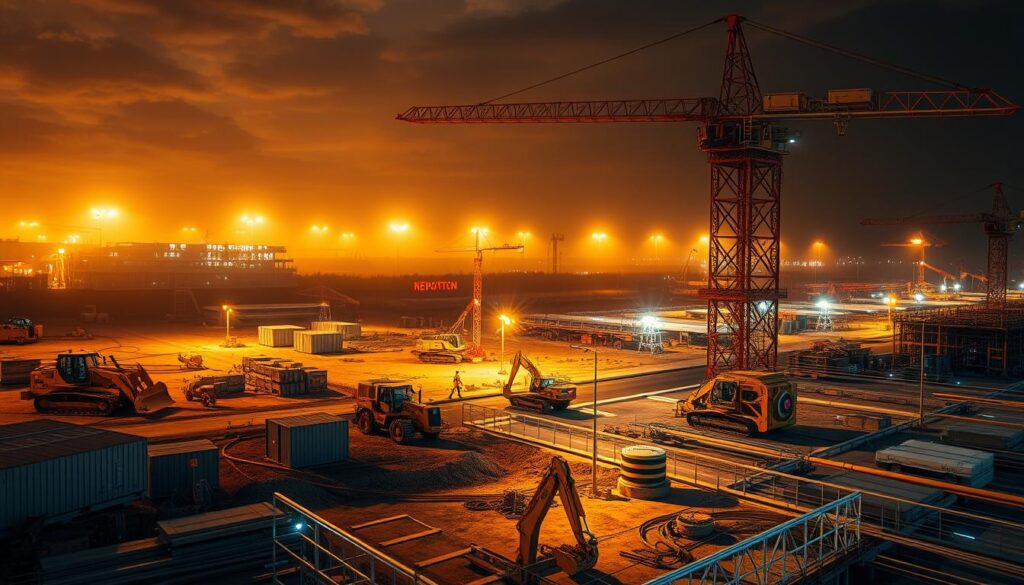The construction industry is on the cusp of a revolution, with the global smart building market projected to grow significantly, driven by advancements in IoT, AI, and cloud computing. By 2030, construction output is expected to rise by 85% to $15.5 trillion, with China, the U.S., and India leading the way. Construction technology advancements are transforming the way cities are built and managed.
As noted in a recent report, the adoption of technologies like Building Information Modeling (BIM), drones, and Construction Robotics is accelerating construction projects while maintaining precision. For more insights on emerging trends, visit Intellectsoft’s blog on emerging construction technology.
Key Takeaways
- The global smart building market is projected to grow significantly.
- Construction output is expected to rise by 85% to $15.5 trillion by 2030.
- BIM has evolved into Digital Information Management (DIM).
- Drones and Construction Robotics are accelerating construction projects.
- Data analytics drives smarter decision-making in construction projects.
Revolutionizing Construction with Robotics
The construction industry is on the cusp of a revolution, driven by the integration of robotics and automation. This transformation is enhancing the efficiency, precision, and safety of complex construction projects.
Robotics in construction is not just a futuristic concept; it’s a current reality that’s changing how buildings and infrastructure are designed and constructed. The use of robots is becoming increasingly prevalent, from automated bricklaying to robotic demolition. These advancements are part of the broader construction technology advancements that are reshaping the industry.
Types of Construction Robots
There are several types of construction robots being utilized across various projects. Some of the most notable include:
- Bricklaying Robots: Capable of laying bricks at a much faster rate than human labor, these robots are improving efficiency on construction sites.
- Demolition Robots: Equipped with advanced tools, these robots can safely demolish structures without putting human workers at risk.
- Inspection Robots: These robots are used to inspect construction sites, identifying potential issues before they become major problems.
For more insights on how technology is transforming civil engineering, visit World Civil Society to explore the impact of AI in the field.
Benefits of Robotics in Construction
The integration of robotics into construction projects offers numerous benefits, including:
- Improved Efficiency: Robots can work around the clock without breaks, significantly speeding up project timelines.
- Enhanced Precision: Robotics reduces the likelihood of human error, leading to higher quality construction.
- Reduced Labor Costs: By automating certain tasks, construction companies can lower their labor expenses.
The adoption of robotics and automated building processes is revolutionizing the construction industry. As technology continues to evolve, we can expect to see even more innovative applications of robotics in construction.
The Role of AI in Smart Infrastructure

The integration of AI in smart infrastructure is revolutionizing the way we design, build, and maintain modern buildings and cities. By leveraging AI and machine learning, buildings can learn from data patterns and optimize their operations automatically, leading to improved energy efficiency and occupant comfort.
AI-Powered Design Tools
AI-powered design tools are transforming the architectural and engineering landscape by providing innovative solutions for complex design challenges. These tools enable architects and engineers to create more efficient and sustainable designs by analyzing vast amounts of data and identifying optimal design parameters.
Key benefits of AI-powered design tools include:
- Enhanced design accuracy and precision
- Improved collaboration among project stakeholders
- Automated generation of design alternatives
- Optimization of building performance and energy efficiency
Predictive Maintenance with AI
Predictive maintenance is another critical area where AI is making a significant impact in smart infrastructure. By analyzing data from various sensors and sources, AI algorithms can predict when maintenance is required, reducing downtime and improving overall infrastructure reliability.
The advantages of predictive maintenance with AI include:
- Reduced maintenance costs through timely interventions
- Minimized downtime and improved infrastructure availability
- Enhanced safety through early detection of potential issues
- Data-driven decision-making for maintenance activities
By embracing AI in smart infrastructure, we can create more sustainable, efficient, and resilient buildings and cities. As AI technology continues to evolve, its role in shaping the future of infrastructure will only continue to grow.
Advancements in Building Information Modeling (BIM)
Advancements in BIM are redefining the landscape of modern construction, enabling more precise and efficient project management. BIM has evolved beyond its initial role, now incorporating various digital construction techniques to enhance project outcomes.
The integration of BIM with other technologies is a significant factor in its advancement. One such integration is with the Internet of Things (IoT), which allows for real-time data collection and monitoring. BIM advantages for civil engineers are further amplified when combined with IoT, enabling better decision-making and project management.
Integration of BIM with IoT
The fusion of BIM and IoT is transforming the construction industry by creating a more connected and responsive project environment. IoT devices can feed real-time data into BIM models, allowing for instantaneous updates and more accurate project tracking.
This integration facilitates:
- Enhanced monitoring and control of construction sites
- Predictive maintenance through real-time data analysis
- Improved collaboration among project stakeholders
Virtual Reality in BIM Planning
Virtual Reality (VR) is another technology that is being integrated with BIM to enhance planning and visualization. VR allows stakeholders to immerse themselves in the BIM model, gaining a better understanding of the project’s design and potential issues.
| Benefits of VR in BIM | Description |
|---|---|
| Enhanced Visualization | Stakeholders can visualize the project in a more engaging and interactive manner. |
| Improved Collaboration | VR facilitates better communication among team members by providing a shared understanding of the project. |
| Error Reduction | By identifying potential issues in the virtual model, errors can be mitigated before they occur on site. |
The combination of BIM, IoT, and VR is setting a new standard in the construction industry, driving efficiency, and improving project outcomes. As these technologies continue to evolve, we can expect even more innovative applications in the field of construction.
Prefabrication and Modular Construction Trends

Prefabrication and modular construction are revolutionizing the global construction landscape by offering faster, more sustainable building solutions. These innovative methods are gaining traction worldwide due to their potential to reduce construction time, improve quality, and minimize environmental impact.
Benefits of Modular Construction
Modular construction offers several benefits, including reduced construction time, improved quality, and minimized waste. By manufacturing building components in a controlled factory environment, modular construction reduces the reliance on weather conditions and site-specific challenges, leading to more predictable project timelines.
The benefits of modular construction can be summarized as follows:
- Faster construction times
- Improved quality control
- Reduced waste and environmental impact
- Enhanced safety
Case Studies of Successful Prefabrication
Several projects worldwide have successfully implemented prefabrication and modular construction techniques. For instance, Volumetric Building Companies have utilized modular construction to deliver high-quality buildings quickly and efficiently.
| Project | Location | Benefits |
|---|---|---|
| Modular Office Building | New York, USA | Reduced construction time by 50% |
| Prefabricated Housing | Singapore | Improved quality and reduced waste |
| Modular Hospital | London, UK | Enhanced safety and faster delivery |
These case studies demonstrate the potential of prefabrication and modular construction to transform the construction industry. As the demand for efficient, sustainable building solutions continues to grow, the adoption of these innovative methods is expected to increase.
3D Printing in Construction
The construction industry is on the cusp of a revolution, driven by advancements in 3D printing technology that promise to redefine building processes.
Techniques and Materials Used
3D printing in construction involves various techniques, including Contour Crafting and Fused Deposition Modeling, which enable the creation of complex structures with precision. The materials used range from concrete and cement-based mixes to specialized polymers, offering a wide range of possibilities for building design and functionality.
The use of these materials and techniques not only enhances the structural integrity of buildings but also contributes to sustainability by minimizing waste and reducing the need for traditional construction materials.
Notable 3D Printed Structures
Several notable structures around the world have been constructed using 3D printing technology, showcasing its potential. For instance, the WinSun Company in China has successfully printed numerous buildings, including a five-story apartment complex and several homes, demonstrating the scalability of this technology.
Another example is the Apis Cor 3D printed house in Russia, which was constructed in just 24 hours, highlighting the speed and efficiency that 3D printing can bring to construction projects.
These examples underscore the versatility and potential of 3D printing in construction, paving the way for further innovations in the field.
Drones: Enhancing Site Surveying and Monitoring

With the advent of drone technology, construction companies are now able to conduct site surveys and monitoring with unprecedented precision. Drones equipped with AI and machine learning capabilities are transforming the construction landscape by providing real-time aerial imagery and site monitoring, thereby improving project management and safety.
Advantages of Using Drones
The integration of drones in construction offers several advantages, including enhanced accuracy, reduced risk, and improved efficiency. Drones can capture detailed aerial imagery and topographic data, which can be used to create precise 3D models of the construction site. This information is invaluable for project planning, monitoring progress, and identifying potential issues early on.
Key Benefits:
- Improved accuracy in site surveys and monitoring
- Enhanced safety by reducing the need for manual site inspections
- Increased efficiency in data collection and analysis
According to a report by a leading construction technology firm, “Drones are becoming an essential tool in construction, enabling companies to monitor sites more effectively and make data-driven decisions.” This underscores the growing importance of drone technology in the construction industry.
Drone Regulations and Safety
While drones offer numerous benefits, their use in construction is subject to various regulations and safety considerations. Operators must comply with local aviation laws, obtain necessary permits, and ensure that drones are operated safely to avoid accidents.
| Regulatory Aspect | Description |
|---|---|
| Licensing | Operators must obtain a license to operate drones commercially |
| Safety Protocols | Implementation of safety protocols to prevent accidents and ensure secure operation |
| Privacy | Compliance with privacy laws to protect sensitive information |
As drone technology continues to evolve, it is likely that regulations will adapt to accommodate its growing use in construction. Companies must stay informed about these developments to ensure compliance and maximize the benefits of drone technology.
“The use of drones in construction is not just a trend; it’s a revolution that is changing how we approach site surveying and monitoring.” –
In conclusion, drones are significantly enhancing site surveying and monitoring in construction, offering numerous advantages while requiring careful consideration of regulations and safety. As the technology advances, its impact on the construction industry is expected to grow, contributing to smarter and more efficient construction practices.
Smart Sensors for Real-Time Data Collection
Smart sensors are transforming the construction industry by enabling real-time data collection and analysis. This technological advancement is crucial for cutting-edge infrastructure advancements, allowing for more efficient and informed decision-making processes.
The use of smart sensors in construction projects facilitates the collection of accurate and timely data, which is essential for monitoring project progress, identifying potential issues, and optimizing resource allocation.
Types of Smart Sensors
There are various types of smart sensors utilized in construction, each serving a specific purpose:
- Environmental sensors monitor temperature, humidity, and other environmental factors that could impact construction materials and processes.
- Structural sensors track the integrity and stability of buildings and infrastructure, detecting any signs of strain or damage.
- Motion sensors are used to monitor movement and activity on construction sites, enhancing security and safety.
| Type of Sensor | Application | Benefits |
|---|---|---|
| Environmental | Monitoring weather conditions | Prevents damage to materials |
| Structural | Assessing building integrity | Ensures safety and durability |
| Motion | Enhancing site security | Reduces theft and accidents |
Impact on Project Management
The integration of smart sensors into construction projects significantly impacts project management by enabling real-time data collection. This allows project managers to:
- Make informed decisions based on current data
- Identify and address potential issues promptly
- Optimize resource allocation and reduce costs
For more insights on how technology is revolutionizing modern infrastructure, visit CIM.io’s blog on smart building. Additionally, exploring the latest technology in bridge construction can provide further understanding of smart sensors’ applications, as discussed on World Civil Society.
Sustainable Building Practices in Smart Infrastructure

As the world moves towards smarter infrastructure, the emphasis on sustainable building practices is gaining momentum. This shift is driven by the need to reduce the environmental footprint of construction projects while enhancing their efficiency and longevity.
Green Materials in Construction
The use of green materials is a cornerstone of sustainable building practices. These materials are sourced and manufactured in ways that minimize environmental impact. Examples include recycled materials, sustainably sourced wood, and low-carbon concrete. The adoption of such materials not only reduces the ecological footprint of construction but also improves indoor air quality and occupant health.
Energy Efficiency Innovations
Energy efficiency is another critical aspect of sustainable building practices. Innovations in this area include the development of energy-efficient building envelopes, advanced HVAC systems, and the integration of renewable energy sources such as solar and wind power. These technologies help reduce the energy consumption of buildings, lower operational costs, and decrease greenhouse gas emissions.
Furthermore, the use of smart technologies, such as IoT sensors and building management systems, enables real-time monitoring and optimization of energy use, further enhancing the sustainability of smart infrastructure projects.
The Internet of Things (IoT) in Smart Cities
IoT is playing a crucial role in transforming cities into smart, connected infrastructure. By integrating IoT technology, cities can enhance the efficiency and sustainability of urban environments.
Applications in Urban Planning
IoT applications in urban planning are vast and varied. They include smart traffic management systems that reduce congestion, smart energy grids that optimize energy distribution, and smart water management systems that detect leaks and predict demand.
Smart Traffic Management: IoT sensors can monitor traffic flow in real-time, adjusting signal timings to minimize congestion and reduce travel times.
Smart Energy Grids: IoT enables the integration of renewable energy sources into the grid, improving efficiency and reducing reliance on fossil fuels.
Future of Connected Infrastructure
The future of connected infrastructure lies in the seamless integration of IoT devices and data analytics. This integration will enable cities to become more responsive to the needs of their citizens.
| Aspect | Current State | Future Development |
|---|---|---|
| Traffic Management | Basic traffic monitoring | AI-driven traffic prediction and optimization |
| Energy Distribution | Traditional grid systems | Smart grids with IoT and renewable energy integration |
| Public Safety | Static surveillance systems | IoT-enabled real-time surveillance and emergency response |
As cities continue to adopt IoT technologies, we can expect to see significant improvements in the quality of urban living. The key will be to ensure that these technologies are integrated in a way that is secure, efficient, and beneficial to all citizens.
Construction Tech Startups to Watch in 2023

Construction tech startups are at the forefront of innovation, bringing new solutions to the construction industry’s most pressing challenges. These startups are leveraging technologies like AI, BIM, and modular construction to transform the way buildings are designed, constructed, and operated.
Noteworthy Innovations from Startups
Several construction tech startups are making waves with their innovative solutions. For instance, some are developing AI-powered tools to enhance project management, while others are creating advanced materials that improve building sustainability.
- AI-Powered Project Management: Startups are using AI to predict project delays, optimize resource allocation, and improve collaboration among stakeholders.
- Advanced Materials: Innovations in materials science are leading to the development of sustainable, durable, and high-performance building materials.
- Modular Construction: Modular construction techniques are being adopted by startups to reduce construction time, minimize waste, and enhance quality control.
Investment Trends in Construction Tech
The construction tech sector is attracting significant investment as venture capitalists and investors recognize the potential for growth and returns. Key areas attracting investment include:
- Software Solutions: Investors are backing startups that develop software solutions for project management, BIM, and construction operations.
- Sustainable Technologies: There’s a growing interest in startups that are developing sustainable technologies, such as energy-efficient systems and green building materials.
- Innovative Manufacturing: Startups involved in innovative manufacturing processes, like 3D printing and modular construction, are also receiving substantial investment.
As construction tech startups continue to innovate and attract investment, they are poised to drive significant change in the construction industry, making it more efficient, sustainable, and technologically advanced.
Overcoming Challenges in Automated Construction
Despite its benefits, automated construction technology faces several barriers to widespread adoption. The industry must address these challenges to fully leverage the potential of automation.
Common Barriers to Adoption
Several factors hinder the adoption of automated construction technology. These include:
- High Initial Costs: The investment required for automated construction equipment and software can be prohibitively expensive for many companies.
- Skill Gaps: The operation and maintenance of automated construction technology require specialized skills, which can be in short supply.
- Integration Challenges: Integrating new automated systems with existing infrastructure and processes can be complex and time-consuming.
Addressing these barriers is crucial for the successful adoption of automated construction technology. Companies can explore innovative financing models and training programs to mitigate these challenges.
Strategies for Successful Implementation
To overcome the challenges in adopting automated construction technology, companies can adopt several strategies:
- Phased Implementation: Gradually introducing automated systems into existing workflows can help minimize disruption and allow for adjustments as needed.
- Training and Development: Investing in employee training ensures that the workforce has the necessary skills to operate and maintain automated technology.
- Collaboration and Partnerships: Collaborating with technology providers and industry partners can facilitate the sharing of best practices and reduce integration challenges.
By understanding the common barriers to adoption and implementing strategies to overcome them, the construction industry can accelerate the adoption of automated construction technology.
Workforce Implications of Construction Tech Innovations

Technological innovation in construction is not only changing how projects are executed but also reshaping the workforce that delivers them. As the industry continues to adopt new technologies, there is a growing need to address the implications for the workforce.
Training Needs for New Technologies
The introduction of advanced technologies such as robotics, AI, and BIM requires workers to acquire new skills. Training programs are essential to ensure that the workforce can effectively utilize these technologies. For instance, workers need to understand how to operate and maintain robotic equipment, interpret data from AI-powered systems, and navigate complex BIM software.
A study on the economic consequences of a highly automated construction highlights the need for significant investment in workforce training. The report emphasizes that training programs should be tailored to the specific needs of the industry, focusing on emerging technologies and their practical applications.
The Future of Jobs in Construction
The future of jobs in construction is likely to be influenced by the continued adoption of automation and AI. While some tasks may become automated, new technologies are also expected to create new job opportunities that we cannot yet anticipate. For example, the growing use of drones in construction is creating a demand for professionals skilled in drone operation and data analysis.
| Job Category | Impact of Technology | New Skills Required |
|---|---|---|
| Construction Management | Increased use of BIM and project management software | Proficiency in BIM software, project management tools |
| Skilled Trades | Adoption of robotics and automation | Understanding of robotic equipment operation and maintenance |
| Data Analysis | Growing reliance on data-driven decision-making | Data analysis skills, interpretation of AI-generated insights |
The construction industry must be proactive in addressing the workforce implications of technological innovation. By investing in training and development programs, the industry can ensure that its workforce is equipped to thrive in a rapidly changing technological landscape.
Government Regulations and Policies Shaping the Industry
The construction industry is witnessing a significant shift due to government policies and regulations that encourage technological advancements. These regulations are not only transforming the way construction projects are executed but also paving the way for a more sustainable and efficient future.
Impact of Legislation on Construction Tech
Legislation plays a crucial role in the adoption of new technologies in the construction industry. For instance, regulations that mandate the use of Building Information Modeling (BIM) have accelerated its adoption globally. According to a report, the use of BIM has increased by 50% in the past five years due to government initiatives. As noted in a blog post on the role of government policies in the international construction, such legislative support is crucial for the widespread adoption of construction technologies.
The impact of legislation is not limited to technology adoption; it also influences the overall direction of the industry. For example, regulations focusing on sustainability have driven the development and use of green materials in construction. A guide on cutting construction costs in Africa highlights how such regulations can lead to cost savings and environmental benefits.
Incentives for Technological Adoption
Governments around the world are offering various incentives to encourage the adoption of new technologies in construction. These incentives range from tax breaks to subsidies for companies that invest in innovative technologies. For example, a government might offer a tax credit for companies that implement energy-efficient solutions in their projects.
| Type of Incentive | Description | Example |
|---|---|---|
| Tax Breaks | Reduction in tax liability for companies adopting new technologies. | A company receives a 20% tax credit for implementing solar panels in a construction project. |
| Subsidies | Direct financial support for the adoption of specific technologies. | A government provides a subsidy to cover 30% of the cost of purchasing BIM software. |
| Grants | Funds provided for research and development of new construction technologies. | A research institution receives a grant to develop more efficient 3D printing techniques for construction. |
These incentives are crucial in driving the industry towards a more technologically advanced and sustainable future. By understanding and leveraging these government regulations and incentives, construction companies can stay ahead of the curve and contribute to the evolution of the industry.
Case Studies: Successful Implementations

Cities are embracing smart infrastructure to enhance the quality of life for their residents. This shift towards smarter urban development is not just a trend; it’s a necessity for sustainable growth. In this section, we will explore some notable case studies that highlight the success of smart infrastructure projects.
Domestic Examples of Smart Infrastructure
The United States has seen numerous innovative smart infrastructure projects. One such example is the smart grid system implemented in Boulder, Colorado. This project involved the installation of advanced metering infrastructure, which allows for real-time monitoring and management of energy consumption.
Key Features of the Boulder Smart Grid:
- Advanced Metering Infrastructure (AMI)
- Real-time Data Analytics
- Enhanced Consumer Engagement
| Project | Location | Key Benefits |
|---|---|---|
| Boulder Smart Grid | Boulder, Colorado | Improved Energy Efficiency, Reduced Costs |
| Smart Traffic Management | Los Angeles, California | Reduced Congestion, Improved Air Quality |
International Success Stories
Globally, cities are also making significant strides in smart infrastructure. Singapore’s Smart Nation initiative is a prime example, focusing on integrating technology into urban planning to create a more livable and sustainable environment.
Singapore’s Smart Nation Initiative Includes:
- Smart Transportation Systems
- Public Safety Initiatives
- Digital Government Services
These case studies demonstrate the potential of smart infrastructure to transform urban landscapes and improve the lives of citizens. By embracing technology and innovation, cities can become more efficient, sustainable, and livable.
The Future of Automated Construction Tech
Automated construction technology is on the cusp of a significant breakthrough, driven by emerging trends and predictions. The integration of advanced technologies such as AI, IoT, and robotics is set to revolutionize the construction industry.
Emerging Trends to Watch
Several emerging trends are expected to shape the future of automated construction. Artificial Intelligence (AI) and Machine Learning (ML) are being increasingly adopted to improve project planning, execution, and monitoring. Robotics is another area that is gaining traction, with robots being used for tasks such as bricklaying, welding, and demolition.
The use of Building Information Modeling (BIM) is also becoming more prevalent, allowing for more accurate planning and execution of construction projects. Additionally, the integration of Internet of Things (IoT) devices is enabling real-time monitoring and data collection, leading to more efficient project management.
Predictions for the Next Decade
Looking ahead to the next decade, we can expect to see significant advancements in automated construction technology. One prediction is that 3D printing will become more widespread, allowing for the rapid creation of complex structures. Another prediction is that autonomous construction vehicles will become more common, improving safety and reducing labor costs.
The industry is also likely to see increased adoption of sustainable building practices, driven by the need to reduce environmental impact. Furthermore, the use of augmented reality (AR) and virtual reality (VR) is expected to become more prevalent, enhancing the design and construction process.
As these trends and predictions unfold, the construction industry is poised to undergo a significant transformation, driven by the adoption of automated construction technologies.
Conclusion: A New Era in Construction and Infrastructure
The construction industry is on the cusp of a revolution, driven by technological innovations that promise to transform practices and outcomes. As discussed, advancements in automated construction tech and smart infrastructure are redefining the sector.
Transformative Innovations
Key innovations such as robotics, AI, BIM, 3D printing, and IoT are enhancing efficiency, sustainability, and productivity. These technologies are not only improving project management but also enabling the creation of complex infrastructure.
Embracing Change
To fully leverage these advancements, industry stakeholders must be willing to embrace technological change. By adopting these innovations, companies can stay competitive, reduce costs, and deliver high-quality projects. The future of construction and infrastructure is bright, with technology playing a pivotal role in shaping it.
